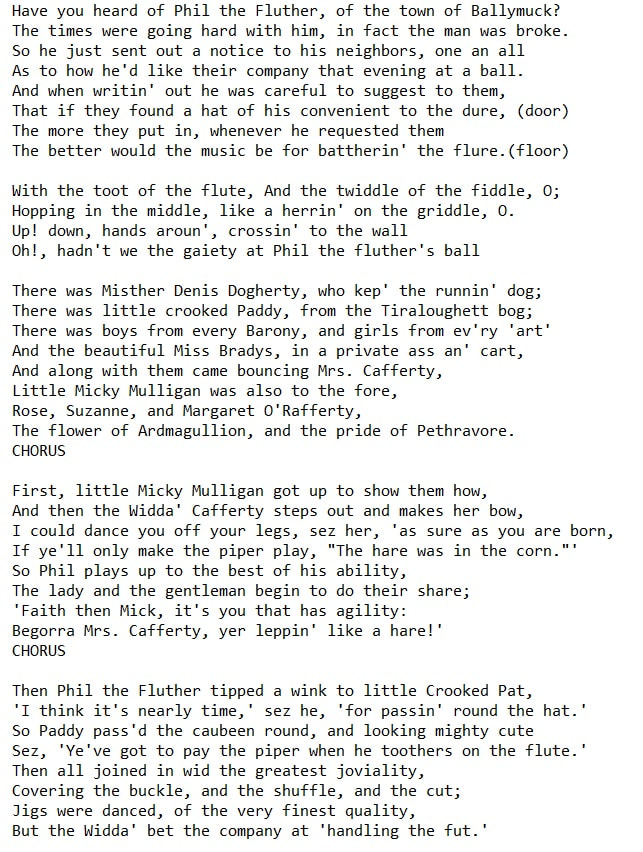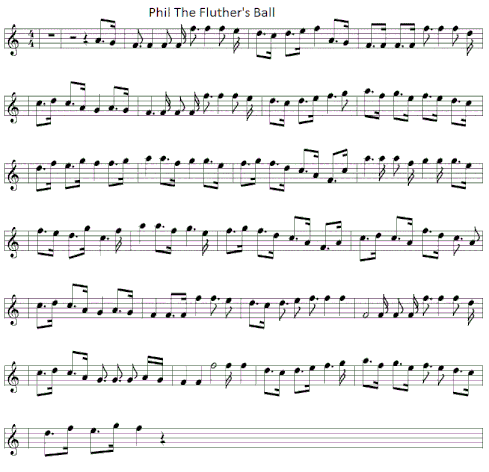Phil the Fluter's Ball lyrics and guitar chords
Written by Percy French, Sang here by Brendan O'Dowda in the youtube video, also recorded by The Two Ronnies, Peter Dawson.The sheet music notes are included. This song uses the same tune of Delaney's Donkey.
Have you (G)heard of Phil the Fluther, of the (C)town of Bally(Bm)muck?
The (G)times were going (Bm)hard with him, in (G)fact the man was (D)broke.
So he (G)just sent out a notice to his (C)neighbors, one an (Bm)all
As to (G)how he'd like their company that (C)evening (D)at a (G)ball.
And when writin' (D)out he was (Em)careful to (Bm)suggest to them,
That (G)if they found a (D)hat of his con(A)venient to the (D)dure, (door)
The (G)more they put (D)in, when(Em)ever he re(Bm)quested them
The better would the (G)music be for (Bm)battherin' the (D)flure.(floor)
With the (G)toot of the flute, And the (C)twiddle of the (G)fiddle, O;
Hopping in the middle, like a herrin' on the (D)griddle, O.
(G)Up! down, hands aroun', (C)crossin' to the (G)wall
Oh!, hadn't we the gaiety at (C)Phil the (D)fluther's (G)ball
There was Misther Denis Dogherty, who kep' the runnin' dog;
There was little crooked Paddy, from the Tiraloughett bog;
There was boys from every Barony, and girls from ev'ry 'art'
And the beautiful Miss Bradys, in a private ass an' cart,
And along with them came bouncing Mrs. Cafferty,
Little Micky Mulligan was also to the fore,
Rose, Suzanne, and Margaret O'Rafferty,
The flower of Ardmagullion, and the pride of Pethravore.
CHORUS
First, little Micky Mulligan got up to show them how,
And then the Widda' Cafferty steps out and makes her bow,
I could dance you off your legs, sez her, 'as sure as you are born,
If ye'll only make the piper play, "The hare was in the corn."'
So Phil plays up to the best of his ability,
The lady and the gentleman begin to do their share;
'Faith then Mick, it's you that has agility:
Begorra Mrs. Cafferty, yer leppin' like a hare!'
CHORUS
Then Phil the Fluther tipped a wink to little Crooked Pat,
'I think it's nearly time,' sez he, 'for passin' round the hat.'
So Paddy pass'd the caubeen round, and looking mighty cute
Sez, 'Ye've got to pay the piper when he toothers on the flute.'
Then all joined in wid the greatest joviality,
Covering the buckle, and the shuffle, and the cut;
Jigs were danced, of the very finest quality,
But the Widda' bet the company at 'handling the fut.'
The (G)times were going (Bm)hard with him, in (G)fact the man was (D)broke.
So he (G)just sent out a notice to his (C)neighbors, one an (Bm)all
As to (G)how he'd like their company that (C)evening (D)at a (G)ball.
And when writin' (D)out he was (Em)careful to (Bm)suggest to them,
That (G)if they found a (D)hat of his con(A)venient to the (D)dure, (door)
The (G)more they put (D)in, when(Em)ever he re(Bm)quested them
The better would the (G)music be for (Bm)battherin' the (D)flure.(floor)
With the (G)toot of the flute, And the (C)twiddle of the (G)fiddle, O;
Hopping in the middle, like a herrin' on the (D)griddle, O.
(G)Up! down, hands aroun', (C)crossin' to the (G)wall
Oh!, hadn't we the gaiety at (C)Phil the (D)fluther's (G)ball
There was Misther Denis Dogherty, who kep' the runnin' dog;
There was little crooked Paddy, from the Tiraloughett bog;
There was boys from every Barony, and girls from ev'ry 'art'
And the beautiful Miss Bradys, in a private ass an' cart,
And along with them came bouncing Mrs. Cafferty,
Little Micky Mulligan was also to the fore,
Rose, Suzanne, and Margaret O'Rafferty,
The flower of Ardmagullion, and the pride of Pethravore.
CHORUS
First, little Micky Mulligan got up to show them how,
And then the Widda' Cafferty steps out and makes her bow,
I could dance you off your legs, sez her, 'as sure as you are born,
If ye'll only make the piper play, "The hare was in the corn."'
So Phil plays up to the best of his ability,
The lady and the gentleman begin to do their share;
'Faith then Mick, it's you that has agility:
Begorra Mrs. Cafferty, yer leppin' like a hare!'
CHORUS
Then Phil the Fluther tipped a wink to little Crooked Pat,
'I think it's nearly time,' sez he, 'for passin' round the hat.'
So Paddy pass'd the caubeen round, and looking mighty cute
Sez, 'Ye've got to pay the piper when he toothers on the flute.'
Then all joined in wid the greatest joviality,
Covering the buckle, and the shuffle, and the cut;
Jigs were danced, of the very finest quality,
But the Widda' bet the company at 'handling the fut.'
The pdf version of the sheet music has the lyrics and chords included and it's in the key of C Major.



